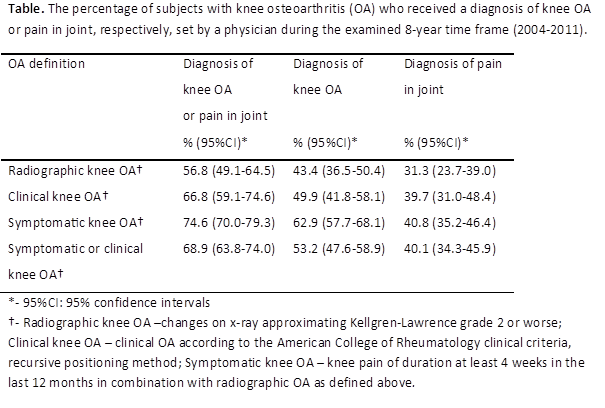Session Information
Session Type: Abstract Submissions (ACR)
Background/Purpose: To provide estimates of the proportion of subjects with knee osteoarthritis (OA) that seek healthcare for knee OA or joint pain within an 8-year period.
Methods: In 2007 a random sample of 10 000 56 to 84 year old Region Skåne residents from the Malmö Diet and Cancer Study (Manjer et al 2001) were sent a mailed questionnaire about knee pain in the last 12 months; this being the first part of the Malmö Osteoarthritis Study (MOA). We classified subjects with knee pain with duration of at least 4 weeks as having frequent knee pain. A random sample of 1300 subjects with frequent knee pain and a random sample of 650 subjects without (out of the 7737 questionnaire responders) were invited for a clinical and radiographic examination including assessment of clinical knee OA according to the American College of Rheumatology (ACR) clinical criteria. Participants underwent radiography of both knees in weight-bearing and semi-flexion. An independent radiologist who was blinded to clinical data assessed all frontal and patellofemoral radiographs. Subjects who fulfilled criteria approximating Kellgren and Lawrence (KL) grade 2 or worse were considered as having radiographic knee OA. We considered those having radiographic knee OA and frequent knee pain to have symptomatic knee OA. Using the subject’s personal identification number and individual linkage with the Skåne Health Care Register, covering the entire population in the county, we retrieved information on all doctor visits with a diagnosis of knee OA (ICD-10 code M17) or pain in joint (joint unspecified, ICD-10 code M25.5) for the years 2004 to 2011, i.e. the 8-year period preceding and following the MOA examination. We used weighting to adjust for different sampling probabilities depending on the knee pain status as well as for the nonresponse and volunteer bias in the MOA study. We used multiple imputation to account for missing diagnostic codes in the register.
Results: The 10 000 MOA subjects had mean (SD) age of 70 (7.6) years, mean (SD) body mass index was 27.1 (5.0) and 62% were women. The response rate in mailed questionnaire was 77.4% and 1527 invited subjects (78.3%) attended the clinical visit. Out of subjects classified as having symptomatic knee OA, 74.6% (95%CI: 70.0% to 79.3%) had consulted a physician during the 8-year time frame and received a diagnosis of knee OA or pain in joint (Table). Among subjects having clinical knee OA the corresponding percentage was 66.8% (95%CI: 59.1% to 74.6%). The ICD-10 diagnosis of knee OA was set in 62.9% (95%CI: 57.7% to 68.1%) of subjects with symptomatic knee OA and 49.9% (95%CI: 41.8% to 58.1%) of patients with clinical knee OA.
Conclusion: Only 2 of 3 subjects with clinical or symptomatic knee OA consult a physician for his/her knee(s) symptoms in an 8-year time frame. Self-management or coping strategies as well as over-the-counter pain treatments are plausible explanations.
Disclosure:
A. Turkiewicz,
None;
M. Gerhardsson de Verdier,
Astra Zeneca,
1,
Astra Zneca,
3;
G. Engström,
Astra Zeneca,
3;
S. Lohmander,
None;
M. Englund,
None.
« Back to 2013 ACR/ARHP Annual Meeting
ACR Meeting Abstracts - https://acrabstracts.org/abstract/the-proportion-of-knee-osteoarthritis-patients-in-southern-sweden-that-seek-medical-car/

